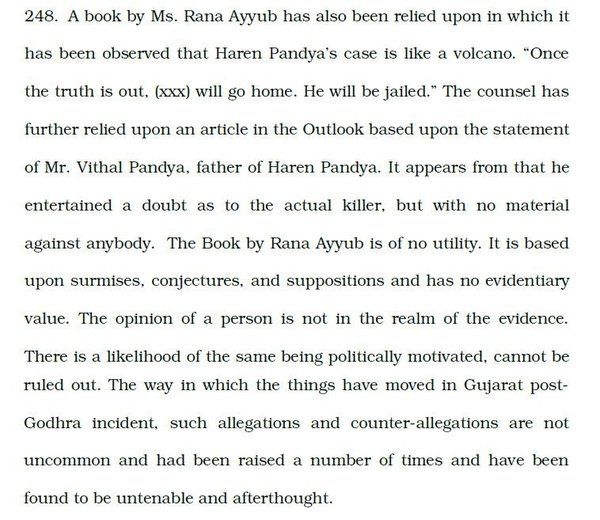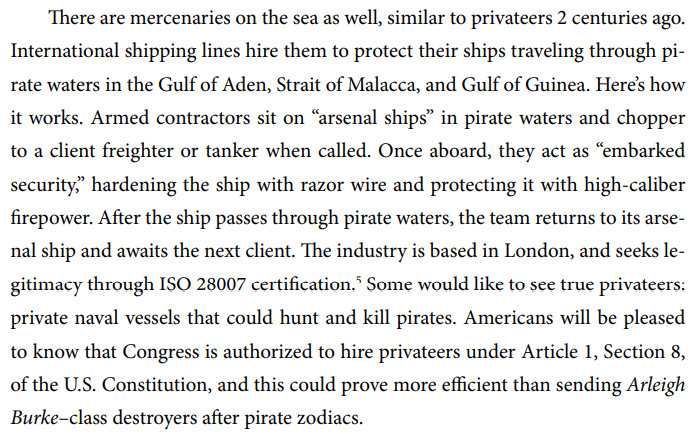Insightful newsletter of Drishtikone: Issue #153 - The Scary World of For-profit Armies

(Photo by Maxim Potkin on Unsplash)
“The most dangerous people in the world are not the tiny minority instigating evil acts, but those who do the acts for them. For example, when the British invaded India, many Indians accepted to work for the British to kill off Indians who resisted their occupation. So in other words, many Indians were hired to kill other Indians on behalf of the enemy for a paycheck. Today, we have mercenaries in Africa, corporate armies from the western world, and unemployed men throughout the Middle East killing their own people - and people of other nations - for a paycheck. To act without a conscience, but for a paycheck, makes anyone a dangerous animal.” - Suzy Kassem
The days of fighting for your nation are passe. The new world is one of the mercenaries who go for the highest profits. Fighting with the best weaponry.
National militaries are being made redundant.
Small countries with deep pockets are spending fortunes to alter global maps and state of the societies. The rich now have the wherewithal to raise their own armies and take over countries.
Robert Clives in the making.
Quite simply, the world is changing right in front of our eyes. And, we are stuck with old roadmaps. Today, we will look into the factors that are defining the new world.
And, that world is scary as heck!
we are Sushant - no, THEY are making US ALL Sushant!
When Seymour Hersh reported in detail about the torture at the Abu Ghraib prison - the sexual misconduct, the severe torture techniques used, and humiliation of the prisoners - the impact of that report was not to score some literary points or show off his contacts. (Source)
The aim was to bring the brunt of public opinion to bear upon a US administration that had violated the international laws in how they treated their prisoners.
The impact of Hersh’s investigative report went far beyond the baring of tactics being used at Abu Ghraib. It cast a very dark shadow over the US Army.
Captain Robert Shuck, Frederick’s military attorney, closed his defense at the Article 32 hearing last month by saying that the Army was “attempting to have these six soldiers atone for its sins.” Similarly, Gary Myers, Frederick’s civilian attorney, told me that he would argue at the court-martial that culpability in the case extended far beyond his client. “I’m going to drag every involved intelligence officer and civilian contractor I can find into court,” he said. “Do you really believe the Army relieved a general officer because of six soldiers? Not a chance.” (Source)
That is the nature of investigative journalism.
It arouses public opinion!
The difference between what, say Arnab Goswami has shared in his programs and what Seymour Hersh shared in his work - is of presentation.
Not necessarily of substance.
Evidence and information, if properly checked and rechecked, when presented should stand to scrutiny.
How it is commented upon - as was also the case with Abu Ghraib’s expose' - is a different matter and also entirely within the rights of a journalist. Some are unscrupulous. Some not.
For 12 years, PM Modi was called all kinds of names. All sorts of evil were attributed to him.
But in the court of law, nothing withstood scrutiny. Nothing! Every court of the land acquitted him.
So, either all the charges were nothing but a bag of stinking baloney or the most vocal of Modi-haters really hid the real evidence somewhere special and could never bring themselves to share it with any court!
Careers of Rajdeep Sardesai, Barkha Dutt, and Rana Ayyub were made on the back of Gujarat riot “reporting” and stories. Stories, that India’s Supreme court dismissed as “surmises, conjectures and suppositions” having “no evidentiary value”. (Source)

Such have been the standards of journalism in India.
Surmises, conjectures, and suppositions as the basis on the longest “media trial” in the history of the country!
Those journalists who conducted that have become heroes of the press. Courted by Washington Post and other global press.
Those whose reporting and award-winning work were based on nothing more than surmises, conjectures, and suppositions, with no evidentiary value. A very nice way of saying fictional nonsense!
Now, DSK Legal - a front organization - has filed a suit specifically against Republic's Arnab Goswami and Pradeep Bhandari and Times Now's Rahul Shivshankar and Navika Kumar for -
“conducting media trials of Bollywood personalities and interfering with the right to privacy of persons associated with Bollywood.”
The suit further states that:
"The livelihood of persons associated with Bollywood is being severely impacted by the smear campaign being run by the Defendants. This is in addition to the ongoing pandemic which has resulted in extreme revenues and work opportunity loss. The privacy of the members of Bollywood is being invaded, and their reputations are being irreparably damaged by painting the entire Bollywood as criminals, seeped in drug culture, and making being part of Bollywood as synonymous with criminal acts in the public imagination." (Source)
These are the organizations who have filed the suit.
While Bollywood biggies join hands to smother the voice of TimesNow and Republic Media, the other press people have decided to join in this situation as cheerleaders of those who are working to shred the freedom of the press. Just not their group’s though.
Generals of these internecine battles in the press being fought are symptomatic of a larger war being fought.
India versus Imperialists.
I am not sure whether you can see or not. But the template of the murder and silencing of Sushant Singh Rajput and Disha Salian is being replayed.
Just that this time, the one they want to hang - is the Indian public!
Time to learn from history - Boycott Bollywood!

Use your wallet very very carefully. It matters. It is your voice!
global armies of for-profit soldiers
What is common between terror groups like Nusra Front, Turkistan Islamic Party, the Nigerian government, the Syrian government, US and Russia Army, Nongovernmental organizations (NGOs) such as CARE, Save the Children, CARITAS, and World Vision, and companies like China National Petroleum Corporation and mining giant Freeport-McMoRan?
They depend on mercenaries.
Or private for-profit armies, as they are called.
After Syria was run over by the ISIS, Syria’s state oil company signed a binding agreement with Russia’s Euro Polis sometime in January 2018, offering it 25% of the profits from the oil refineries that it liberated from the Islamic State terrorists.
The visit of the Syrian Minister of Oil and Mineral Resources Ali Ghanem, who visited Moscow in December 2016, passed without fanfare and was left unnoticed by the Russian press. Only in March 2017, in an interview with Kuwaiti newspaper Al-Siyasa, Russian Energy Minister Alexander Novak announced the talks: "As part of our last meeting with Syrian Oil and Natural Resources Minister Ali Ghanem (December 8, 2016) we discussed the participation of a number of large Russian companies in oil and gas exploration and production projects in the Arab Republic, with a focus on ensuring the safety of their activities there" (quoted on the website of the Russian Ministry of Energy)…… According to information received from a source close to the Ministry of Energy, a serious memorandum was signed with Euro Polis LLC. The contents of the memorandum make sense: Euro Polis LLC undertakes to release oil and gas fields, processing plants, other oil and gas infrastructure, and then protect them. Euro Polis's share in oil and gas production is a quarter, and the costs of fighting are reimbursed separately. The memorandum is valid for 5 years.(Source)
How would Euro Polis do what the Syrian army couldn’t do? It employed a group called Wagner Group. It employs Russian mercenaries armed with the most sophisticated weaponry. A few years back, the Wagner private army of mercenaries fought the American troops in the oil & gas province of Deir ez-Zor in Syria.
At the end of January 2018, very interestingly the Russian Ministry of Energy announced that it had signed with Syria a “road map” for the repair, modernization, and construction of new energy facilities in Syria.

(Translation - Russia and Syria signed a roadmap for energy and electricity)
These private armies made up of mercenaries use the most brutal methods - decapitating and torture - in battles and given their “non-state” status, makes it difficult to take any action against them.
There are 5 domains of warfare for any military in the world - land, sea, air, space, and cyber. Today, except for space, every other domain has a private army of mercenaries.
For example, here is an account of how shipping lines hire “privateers” who are owned by companies with a veneer of legitimacy. And even an ISO certification to boot! (Source)

In the domain of cyberspace, the mercenaries are called “hack back” companies. These hack back companies act as deterrents. So, when a hacker is looking for targets, it skips the corporates that have hired hack back mercenaries.
The business of mercenaries is booming. No one knows how much money is spent by different players, but the US, for example, uses more contractors in its wars than its own soldiers
About 53,000 U.S. contractors were in the Middle East last year, compared with 35,000 U.S. troops, according to a study by Boston University and Brown University. That ratio was 1 to 1 during the height of troop levels in Iraq in 2008. And since 2001, an estimated 8,000 contractors for U.S. companies have died on duty in the Middle East. That figure is 1,000 more than U.S. troops who have been killed (Source)
The difference is that while soldiers get all the respect and the love from their nation, no one cries for the contractors. No one lines up at the airports or gives them any ceremonies.
“You don’t see yellow ribbons around trees for contractors,” said Mark Cancian, a defense budget expert for the Center for Strategic and International Studies. “All these touching scenes of the military service member coming home and scooping his kids up at the airport, you never see that for contractors.” (Source)
Pakistan is emerging as a major player in this market as well. Everyone knows of the strange case of ex Pakistan Army Chief Raheel Sharif being the “military head” of a thirty-nine country coalition called the Islamic Military Counter Terrorism Coalition. (Source)
While India has become the hub for IT and management talent, Pakistan has become the hub for armed mercenaries.
The hiring of Pakistani servicemen for riot policy duty in Bahrain has become a source of controversy, with calls being made that such practices be halted. Munizae Jahangir, the host of one such TV program, said that the recruitment of Pakistani mercenaries was having a larger impact on the Pakistani communities in these countries. In Bahrain, Pakistanis are being targeted by locals because it is felt that they are siding with the country's ruler. (Source)
The Pakistani jihadis are also fanning out in other cities across the world. Most of the Shia fighters in Syria are not from Iran, Iraq or Lebanon, but come from Afghanistan and Pakistan in big numbers.
According to experts, more than 80% of mercenaries that are fighting the Syrian civil war are being imported from other countries with the backing of Iran. (Source)
Saudi Arabia - and even UAE, not just uses Pakistani Army Chief as its mercenary, it also brings in forces from other countries. That is why even with hardly any military, Saudis and the UAE have some of the largest military budgets.
Saudi Arabia currently has the third largest military budget in the world. The UAE military budget is currently unknown, but its military spending is estimated to be the 14th largest in the world. (Source)
Their mercenaries come from Latin American countries. In addition to foreign military forces, the Saudi-led coalition also includes private military contractors, also known as mercenaries.
The largest contingent are Latin American mercenaries made up of fighters from Colombia, Panama, Chile and El Salvador under the general direction of Oscar Garcia Batte, a former Colombian special operations commander. (Source)
The situation is such that the private mercenaries and militias are being used powered by Western firepower in all these conflicts.
new warfare new adversaries and neo-imperialist future
This new scenario - of mercenary fighters was established when the US Army used the Blackwater company in Iraq. That was roughly 20 years back. Today, this market is very sophisticated.
This presents a situation where private armies - by the super-rich, the large corporations, the rich NGOs, small but cash-rich countries, and even regular state Armies can use a global pool of fighters who fight for large profits. And, the arms and weapons manufacturers thrive through them. Which essentially means that they have access to weaponry that is highly sophisticated.
This is the complete marketization of war.
If this continues, we shouldn’t be surprised if a multi-billionaire raises his own army and annexes states that cannot afford or fight for their territory and colonizes them. All with ISO certified organizations in tow!
We may not even have anything called national security or international relations to speak of.
States will go to the highest bidder with the best mercenaries and weapons that money can buy!
If you thought East India Company cannot happen again, get yourself checked. For, when folks like George Soros announce a $1 bn fund to change India’s polity, they do not clarify if that will be backed in the future by armed mercenaries. We all do know that it is backed by an army of “intellectual mercenaries.”
Check out this excellent video for more information.
nota bene
Hurried bridge-building at the border: Defence Minister Rajnath Singh on Thursday formally opened 44 bridges built by the army’s Border Roads Organisation, or BRO, delivering what the government described as a record-breaking performance. The 44 are among the 102 bridges that are being built by the BRO. These bridges are designed to withstand the movement of India’s heaviest battle tanks. An official said 30 of the 44 bridges commissioned on Monday fall on the route to the Line of Actual Control from Ladakh to Arunachal Pradesh. These are class 70 bridges; technicalese for bridges that can bear the weight of 70-tonne vehicles. (Source)
Pakistan and China on a Joint mission against India: India’s northern and eastern frontiers remain tense, with Pakistan and China creating conditions that seem to suggest that “a border dispute is being created under a mission”, defense minister Rajnath Singh said on Monday while drawing attention to the collusive threat posed by the two adversaries. “You are well aware of the conditions created on our northern and eastern borders. First, it was Pakistan, and now also by China, as if a border dispute is being created under a mission. We have a border of about 7,000 kilometers (km) with these countries, where tension prevails on a daily basis,” Singh said, while virtually inaugurating a raft of Border Roads Organisation (BRO) projects to provide connectivity to forward areas. (Source)
Rs 1 lakh crore consumption boost: Finance minister Nirmala Sitharaman announced measures to stimulate consumer spending and capital expenditure that would generate demand of Rs 1 lakh crore, including the private sector, and in turn, help the growth of gross domestic product (GDP). A leave travel concession (LTC) cash voucher scheme and special festive advance scheme for government employees is expected to generate additional consumer demand of Rs 36,000 crore, the government said, pegging the numbers on conservative estimates. Capital expenditure by Centre and states is likely to generate demand of about Rs 37,000 crore. (Source)
Hiring in India is up by 24%: With life returning to normalcy gradually, hiring activities grew 24 percent in September as compared to the previous month mostly driven by pharmaceuticals and education sectors, according to a report. The growth was propelled by industries like pharma, which saw a 44 percent rise in hiring activities, FMCG (43 percent), education and teaching (41 percent), and IT (32 percent), it said. Tier-II cities like Ahmedabad (34 percent), Chandigarh (39 percent), and Jaipur (36 percent) also saw a significant uptick in hiring activities (Source)
Jupiter may have the fastest speed of sound: The fastest possible speed of sound — 22.4 miles per second, nearly twice its speed in the air at the Earth's surface — has been calculated for the first time. British researchers found that such speeds are only possible, however, when passing though metallic hydrogen, as found in the core of the giant planet Jupiter. Sound moves quicker through solids than air because of its higher density. By using standard models of physics along with state of the art mechanical calculations, the researchers showed that sound waves can move the fastest in solid atomic hydrogen. This state of the gas is only found at very high pressures — those above 1 million atmospheres — comparable to those found in the core of gas giants like Jupiter. In such conditions, hydrogen becomes a metal with unusual properties — conducting electricity just like copper. (Source)
world’s strangest city
Have you ever seen a city with hundreds of buildings built with white sparkling marble glistening in bright sun with beautiful architecture? Oh, and buildings that no one lives in?
Check this video out. One of the very few that anyone has been able to make and bring out of this country - Turkmenistan.
Today’s ONLINE PAPER
Check out today’s “The Drishtikone Daily” edition.
Support Drishtikone
If you consider our work important and enriching and would like to contribute to our expenses, please click on the button below to go to the page to send in your contribution. You can select the currency (for example, INR or USD, etc) and the amount you would like to contribute.
If you like this post - please share it with someone who will appreciate the information shared in this edition -
If you like our newsletter, please share it with your friends and family -

Comments ()